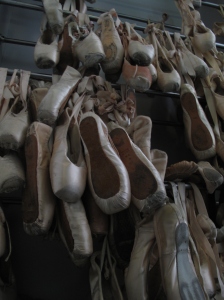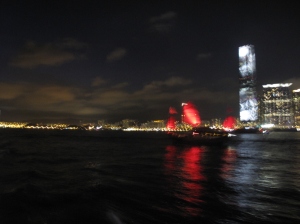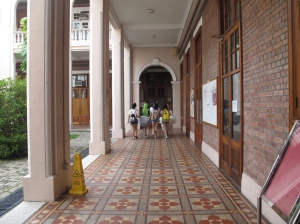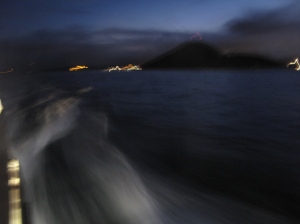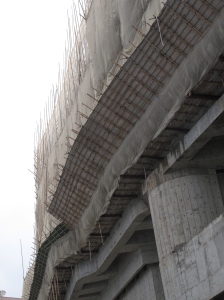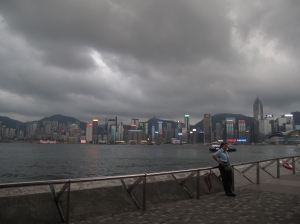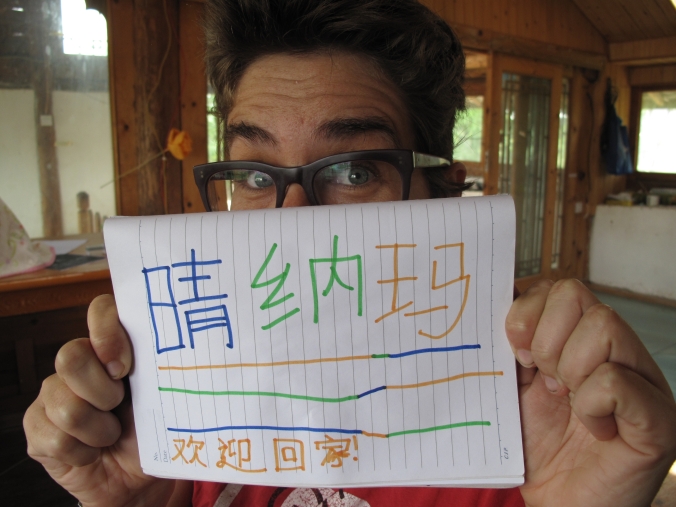On the 9th of June I was driven from Lāshìhǎi to Lìjiāng airport, flew to , took the bus across the border to Hong Kong, and a subway train to my accommodation. On the 26th of June I missed the ferry so took the train to the border, a bus from the other side to airport, flew to Lìjiāng, and got collected by Jay and Miranda and came home to Lāshìhǎi. It was a big 3 weeks. Here are some of the things that happened.
Leaving Home
The day after I left it was my birthday. Miranda organised a whole bunch of friends and family to make little videos, compiled them, and sent them through. It was really one of the loveliest presents I’ve ever received – all those special people thinking of me, taking the time to do such a nice thing, and Miranda asking them all and editing all their clips into 1 film for me. I cried and cried and it was so sweet.
18 Pitt Street
I stayed at a community centre which has some beds on the floor on the mezzanine for folks to stay by donation. It was pretty cramped and the centre was often open later than I was awake, so there were strangers downstairs nearly every day but it more of a chatting atmosphere than a hang-out atmosphere. Thanks to Chi for hosting me there. The locality, Yau Ma Tei (part of MongKok area) was more my type of neighbourhood than the fancy harbourside places. Not totally gentrified, still a bit grungy, a variety of folks, heaps of cheap local noodle shops and steam bun breakfast joints, older people who seemed to be long-term locals, etc.
If you want to contact 18 Pitt Street to stay there or whatnot, you can contact them through fb (fast response), email (slow or no response) 18pittstreet@gmail.com, or phone (no idea) . If you want to drop in, go to 18 Pitt Street Yau Ma Tei, after lunch 7 days/week.
The Modern Academy
The Modern Academy started on Wednesday the 10th, and until the next Wednesday there were only composers. This was a pretty great time, and I think we bonded together as a gang a lot more than the musicians because of this extra week where many of us were in the one small venue.
I met so many great people. I don’t want to leave anyone out so I am not going to list names, but here is a link to the soundcloud of one amazing person called Amadeus, whose composition practice, politics, etc. I really admire and click with:
Dance Module
The dance module was quite intense, but I didn’t REALLY get what I wanted out of it. There were really a lot of communication and organisational issues with TMA. I worked really hard leading up to it to prepare what I understood I needed to prepare. But as it turned out, I would have gotten way more out of preparing way less: just having ideas to develop with the dancers, rather than having a piece done that was able to be modified. Of course, I was a lot less stressed than most the other participants, since my work was already written, but Joyce Beetuan-Koh wanted us to get the experience of developing a work with dancers, not just giving them a piece. I also wanted that experience, as I’ve developed work with directors before, but not with the bodies on the stage directly. But I followed pre-TMA emailed instructions that weren’t really correct, and so got less out of it. However, it was a really tight and supportive group and I got something out of being around for others processes, and also just getting to know everyone, and also watching and listening to the dancers developing my and others work.
Ensemble Gô (String quartet with marimba from Singapore) were our wonderful ensemble on-hand. They didn’t quite know that the y were going to be assigned to a dance collaboration that would require them to contribute physically as well as musically. I hope they felt ok with it all. They were really emotive honest musicians and fun to work with and I thank them so much for all their work! https://www.facebook.com/ensemblego
y were going to be assigned to a dance collaboration that would require them to contribute physically as well as musically. I hope they felt ok with it all. They were really emotive honest musicians and fun to work with and I thank them so much for all their work! https://www.facebook.com/ensemblego
Sarah X and M were our contemporary dancers. Both currently live in Hong Kong after graduating from the Academy of Performing Arts there, but hail from mainland China. It was really great to experience the process of translation from composer’s concepts to dancer’s interpretations. They had the intensive job of co-developing 6 works for performance within a week, all unrelated works with their own aesthetics. Sarah and M are both great dancers and they did a wonderful job. Here’s a link to check out more about Sarah: http://www.springworkshop.org/?lang=en#/?p=4602 and M : http://www.4degreesdance.com/index.php/maowei/
Another wonderful aspect was the opportunity to work with and meet Joyce, Singaporean Composer, and Elysa Wendi, Singaporean choreographer. Elysa is absolutely lovely and incredibly generous, and I love the way she moves and the way she describes and explains the body. Joyce is hilarious and vibrant and efficient and honest and incredibly generous and I love the way she thinks and the concepts and ideas she’s curious about. I really hope I have opportunities to work again with both Elysa and Joyce. Joyce’s website again is: http://jbtkoh.net/
Some of Elysa’s work can be found here: https://elysawendi.wordpress.com/
here: http://www.objectifsfilms.com/product.php?id_product=120
and here:
Dance Performance
I must admit to a bit of frustration leading up to the dance performance. This is because from 4 or 5 days before, we had rehearsals that clashed with the lectures of my 2nd module. I was totally accepting of missing those lectures whilst at the dance module workshops, but for rehearsals it was a bit frustrating, I think for me more than others because they really were just rehearsals, and I wasn’t needed there that much. There was a heap of effort put in by all the performers and I feel really thankful for their dedication. And a heap of effort was also put in to documentation of our pieces. They were audio-recorded without the dancers and filmed with the dancers, separately to the performance. A special thanks to Lau Hiu Kong (Lawrence) and Boo Chun Kit (Donald) for all their work on the recording process.
Here’s an audio track – I’ll post the film of the work here once it gets edited etc.
The performance itself had a really good vibe and everybody’s work went really well. I felt really happy with what the musicians and dancers had achieved for my work with all of their constraints – 1 week; 5 other works within this module; as well as whatever else they had going on! Thanks so much again to Ensemble Gô, Sarah X and M .
Composition Colloquia
I wish I’d more opportunity to engage with the lectures and materials in this module but was quite restricted by the dance module’s timetable. But from the few lectures I went to I learnt some really cool things about micro-tones and just intonation (and other tuning systems), and wrote down lots of composer’s names to look up, and generally felt like my mind was being academically musically engaged which was at times frustrating because I realised how little I know of compositional practice, theory, and history, but was mainly pretty darn exciting. I do love that learning structure!
Work-shopping the Rhododendron piece
I had 2 workshops of this piece that I’d been working so hard on before I came to TMA. But it was really quite a disaster. I didn’t have the full ensemble at either of the workshops and I didn’t know how to lead the piece very well myself when I didn’t have a conductor for one of the workshops (I’m not experienced in leading time-based pieces) and even if I had’ve had really successful workshops, it was a bit disappointing that the piece couldn’t be performed because the instrumentalists I was assigned were leaving before the concert of fellow’s works! Anyway, I did get some feedback from those instrumentalists who came and I thank them for their time and patience in this experiment! Most of them were members of this cool new group called the Asian Contemporary Ensemble, and whilst the workshops weren’t that productive, the ACE members are great musicians, absolutely lovely, and I hope to work with them again sometime. They play a lot of arranged traditional music from around Asia and also new music. Check them out here: http://www.ace-sg.org/
I felt the most productive work on this piece was my discussions with Ken and Eli. But after the workshop I felt it was such a disaster and I couldn’t hear anything enough to imagine it could even be a piece. I really thought I’d have to start again. Then chatted with Ken and Eli about what I am trying to achieve here and how to balance purity of input with musicality of output. For example they asked me, what does a flower opening sound like? Have I achieved my desire to directly translate the data if I am not musically happy with the result? Is there a way Robbie can represent this data for me less discretely, so that I can have more continuous patterns to work with? After this I wrote to Robbie and asked him to produce even more graphs for me! Sorry Robbie! But I discovered that his field data collection actually included a classification of flowers into: buds, open, and dead flowers. This is pretty exciting and some of the data representations he sent me, alongside the new ideas and questions, inspired me to work in that direction, but until now I’ve been too busy to really dig into that.
Soundpainting
In the last few days I did some workshops on soundpainting with Tim O’Dwyer, an Australian saxophonist (member of chamber group Elision). Soundpainting is both simple and complex to explain. I’ll try to, briefly. Soundpainting is not a cross-media art-form but a conducting method with which to direct improvisation/live composition of an instrumental group. It is a proscribed language, invented by one person, which aims to universalise a set of gestures so that performers can read any conductor without having to learn their individual gestures or guess at their meanings during performance. The improvisation/live composition can be quite free (“play a solo”), or very specific (“guitar and percussion play Cminor reggae riff in 4/4 at 120bpm; rest of group play staccato attack notes on cue”). I’m glad I did this module but I don’t feel particularly drawn to Soundpainting. I ended up singing and performed being one of 2 voices in the group on stage (!). In the workshops I really didn’t feel that we were making music. I felt that we were following signals to make certain (types of) sound. But in our performance I did feel that what we did was a piece of music.
Whilst I agree wholeheartedly with the sentiment of universality of some type of language to enable accessibility; I just think that Soundpainting is too strict. I feel that it actually disables the conductor’s own creativity in some ways by having such a rigid set of gestures to choose from. If the conductor does something not in the language (I would say something organic or spontaneous), performers who are experienced with Soundpainting will not follow the instruction even if they understand it. To me this is a weakness. Surely the point of the conducting-performing relationship is communicating; and if an idea is communicated surely it can be followed through, even if the language is original. Another point of critique for me is that there is a special course, led by the inventor, to become an official Soundpainter. I really really do understand the difficulties of surviving as a musician in these profit-centred capitalist societies of ours. But I also do think that a real language should be let go free. Of course, have studies, workshops, etc., of course. But for the whole language to be effectively copyrighted, I find quite a contrary idea to the concept of accessibility, and a bit detracting from the whole idea. But don’t just listen to me – have a look and see what you think: http://www.soundpainting.com/
Anyway, I would like to experience a Soundpainting performance with a really experienced group sometime, and see if I have a very different experience.
Meeting with Ken
On the last day I had a really good hour-long meeting with Ken Ueno. I asked about ways to push my compositional practice given I am not studying or really within any academic community. We talked about the push and pull of his ideas of authenticity and specificity of pieces to particular performers, and my ideas of accessibility of music for performers. I voiced my jealousy of access to academic environments, and we talked about the benefits to my music and I, coming back to it being older, politically strong, and not having completed an academic compositional qualification. We talked about Luigi Nono, an Italian avante-garde and vocally anti-fascist composer, who only started music lessons when he was 17, never studied composition at university, and placed his politics squarely within his work. It was a really good meeting and I came away feeling a little bit inspired and enlightened, and with a lot of work to do.
Days Off
I only had 1 official day off The Modern Academy in Hong Kong, although I took 2. The first day, I went to Lamma Island on my own, like Miranda last month. After waiting for the ferry which included discovering the bizarre and rather sad pedestrian picnic overpass structure, I was extra pleased to see some real green. I followed Miranda’s advice and started at the tiny village with only seafood restaurants, walked across the island, had a swim in the (no doubt highly polluted) ocean, poked around, ate Pad Thai and a beer for dinner in the bigger village, and took a ferry back.
The second day I skipped some lectures and went with Hiu Kong, Amadeus and Scott to Lantau Island, home to the giant sitting Buddha. We took the cable car over the ocean and up the island mountain; visited the big Buddha and his entourage; ate delicious Buddhist food; took bus back down to the coast; took a tiny boat to look for pink dolphins (we didn’t see any); walked around a village; and got a ferry back to the city. It was a really lovely day.
In the evening I went to a UNHCR refugee film festival film, about a whole ethnicity of Bhutanese people who were forcibly kicked out from their country and lived stateless in Nepal in a border camp during 18 years of failed negotiations with the Bhutanese monarchy, before being offered to resettle in the USA. Yes, Bhutan is the country that measures Gross National Happiness, has the national religion of Buddhism but claims freedom of religion, and has a country-wide ban on plastic bags. Yes, we think of it as a secret paradisaical utopian country. Yes, Bhutanese soldiers burned houses, threatened, jailed, tortured and permanently exiled its own citizens, many of whom had been living there for generations, and many of whom’s forebears had been invited to settle there by that same Bhutanese monarchy.
Hong Kong
In Hong Kong I love the weather, especially that warm tropical rain (although those more acclimatised than I seemed to get cold when it rained – it went down from ~32 to ~28 degrees!). I love the political integrity and braveness of many Hong Kong-ese – the umbrella movement; the calls for independence; the tent village that remains outside the central government offices long after the larger protests and live-ins were dispersed by force. And I love the old ferries crossing the harbour – big metal and wooden structures full of history, painted green and white, with wooden bench seats with star designs pressed into the seats and simple backs that flip so that you can face either direction, like older Sydney trains.
But I am really confused as to why people love Hong Kong so much. Of course if somewhere is home, it’s home. But as a visitor, I might say that I could be fascinated by Hong Kong, but I am certainly not in love with it! To the contrary, I felt pretty oppressed most of the time I was there, aside from my days off when I went to the islands and took a breath that had freshness in it, and saw some natural things that weren’t either placed purposely by humans; or struggling in spite of humans, but just there because that’s where they were.
I struggled with so many things in Hong Kong: the verticality of living (subway; streets; underpasses; overpasses; high-rises) to fit so many people in such a small space; the glitzy malls; the cost of living (an average meal is close to Au meal prices in conversion), so much higher than most of mainland China. The inevitable massive resource-sink city footprint of fuel and food and things, things, things, consuming, consuming, consuming. The producedness of everything – even the local chilli sauce is this creamy smooth thing that comes in a bottle, not chopped fresh chilli in vinegar like in Malaysia or dried chilli soaked in hot oil like in . The feeling of busy-ness: it is quite hard to find a seat anywhere in public space in Hong Kong. A lot of HK folk’s life is spent standing up or walking – walking to subway stations, standing at subway stations, walking in malls, standing on subways, walking in the streets, standing on escalators, walking walking standing walking standing…
The lack of recycling and composting facilities; the bland food that’s almost ubiquitous; the persimmon (a fruit native to China, Japan, Burma and Northern India) that I bought for $25HKD (a pear is $3HKD) thinking I was buying an expensive local treat, and then noticed it was imported from New Zealand. The recorded frog sounds in the central city park pond. The air-conditioning in the trains, which didn’t blow whilst at the station, but then started up and blew according to the speed the train was moving, from the direction of travel, so that it really felt like the wind was rushing through your hair and blowing even though we were under the ground inside a train with windows that didn’t open.
I really felt that Hong Kong was some kind of monument to our disconnection with the earth; and I don’t mean that in so much a spiritual sense (although of course that is also true), but in a practical sense: a sense of where did the resources come from that are used every day, how long ago was that meat killed, and where does the waste go, and what did this island look like before high-rises, and what is the weather like and what would lifestyles and structures and diet all need to be like to really live in that weather rather than millions of air-conditioned often windowless units of space, and what community of animal and plant species once called this city their home, and what is underneath the cement and foundations under our millions of feet? A monument to a false idea – the idea that we are completely divorced from our surroundings – from our ecological community – and that we can create whatever kind of place we want, and that that place could continue in perpetuity with our continued ant-like attention to the structures we have invented.
Harmony Music Shop Adventure
So I asked a Hong Kong composer and he asked an instrumentalist friend and I got recommended to go to this particular music shop to buy D (Chinese flutes). I went on my 3rd “day off” (the day I went home). I got up early, packed my bag, and set off up the road in time to arrive at the shop when it opened. I walked through this street that had been blocks and blocks of closed-up shops-in-front-of-shops (permanent street-side stalls) every other time I passed it, and I’d wished I could catch when they were open but when were they open. Now, in the early-ish morning, it was a gloriously crowded hubbub of bustling fruit and vegetable shoppers, and every street-side stall was open as well as every shop in a building, and it was noisy and dirty and hectic and wonderful.
I got to the shop and was overwhelmed by flutes until I asked what the material of the decorative end-pieces was, and discovered they were bone or horn. There were only a couple in the whole collection that just had bamboo ends, and one that had stone. The stone one was in the premium price range and the key I wanted and I played and played it after the attendant had stuck on the membrane for me. But I just couldn’t get it to speak very well and I couldn’t figure it out. The other cheaper one with the bamboo end was easy and enjoyable to play. We tried another membrane and it was a bit easier. I was on a tight timeline so I decided to get the premium stone one, and the all-bamboo one for my uncle, and a soft case for them and a 1/8 size cello bow for Jen back at Lìjiāng Studio to bow cymbals etc., and 2 end-pin stopper things for cello, one green and one a new hollow wooden design to increase the resonance and sound output of the instrument. Whoops! I really could’ve spent all day and much more money in that shop, it had such an amazing range of all-things-musical and the staff were all so lovely. But I had a plane to catch.
We bundled everything up and added everything up and then my card failed. I went to the bank around the corner but no joy. I called Miranda to pop money into my bank but that didn’t work. In the meantime another staff member was desperately trying to create me a paypal account so Miranda could pay from back in J. After so much rushing and waiting, and many frantic text messages and swapping of passwords, I became Harmony Music’s first paypal client and Miranda paid the bill and I rushed out the door clutching my booty of musical delights!
Coming home
I rushed back to 18 Pitt Street and grabbed my bag and rushed to the MTR and rushed to the ferry terminal and rushed up the escalators and rushed to the ticket office. I missed the ferry by 0 minutes (yep, it hadn’t left but ticket sales had closed), and didn’t have 1 1/2 hours up my sleeve to wait for the next one, so I rushed back down the escalators and back onto the MTR and changed train 3 times and got to the border at 2. I passed through the border – back in China! – and saw a flower shop and bought a Nepenthes for Miranda and I even though I’m not sure it will survive in Lìjiāng, and found the bus to the airport and got on and got to the airport at 4pm, perfect! I hopped on my 5pm plane, watched the ocean and the country and the clouds beneath me for hours – so incredible – , hopped out at , got on the next plane, got out at Lìjiāng, collected my bags, and walked through security to find Jay and Miranda with a hand-written sign in Mandarin in coloured texta in the back of her homework book waiting to take me home. HOME!!!!
Qíng Nà Mǎ.
晴 纳 玛





